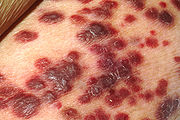
AIDS-related complex
Encyclopedia

ARC is "A prodromal phase of effects phase of infection with the human immunodeficiency virus ( HIV). Laboratory criteria separating AIDS-related complex ( ARC) from AIDS include elevated or hyperactive B-cell humoral immune responses, compared to depressed or normal antibody reactivity in AIDS; follicular or mixed hyperplasia in ARC lymph nodes, leading to lymphocyte degeneration and depletion more typical of AIDS; evolving succession of histopathological lesions such as localization of Kaposi's sarcoma
Kaposi's sarcoma
Kaposi's sarcoma is a tumor caused by Human herpesvirus 8 , also known as Kaposi's sarcoma-associated herpesvirus . It was originally described by Moritz Kaposi , a Hungarian dermatologist practicing at the University of Vienna in 1872. It became more widely known as one of the AIDS defining...
, signaling the transition to the AIDS.
Clinical use of this term was widely discontinued by the year 2000 in the United States after having been replaced by modern laboratory criteria.

